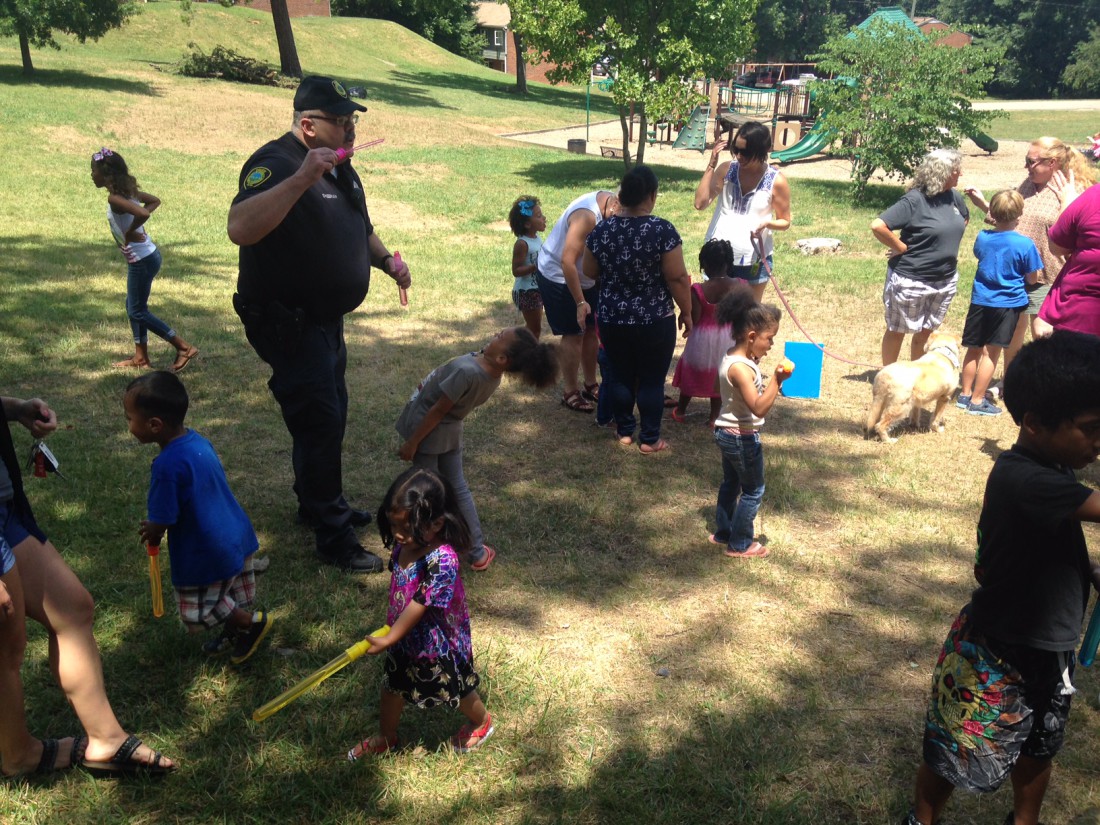Trust in the Asheville Police Department is on the line for some local communities — people of color, the economically disadvantaged and social justice advocates — in the wake of two incidents that have focused local attention on the relationship between the city’s police force and those they are sworn to serve and protect.
On July 2, the fatal shooting of Jai Lateef “Jerry” Williams by APD Sgt. Tyler Radford rocked Asheville. Then, two months after Williams’ death, a 9-second video emerged on Facebook showing Officer Shalin Oza roughly handling a 16-year-old resident of Hillcrest Apartments. According to the APD, the teenager had been interfering while Oza was trying to serve a warrant on her brother.
A year into her leadership of the city’s Police Department, Chief Tammy Hooper now faces her biggest challenges so far in leading an agency marked in recent years by accusations of malfeasance and mismanagement. The two previous chiefs, Bill Hogan and William Anderson, both finished their careers embroiled in scandal. Further fueling public skepticism about local law enforcement, Buncombe’s most notorious lawman, former Sheriff Bobby Medford, is now serving a 15-year sentence in federal prison for corruption and extortion. Additional fallout from his tenure cost local taxpayers $6 million last year, as the county paid a settlement to five men wrongfully convicted during Medford’s watch.
Some in the community have seized on this summer’s two incidents as a catalyst for airing grievances regarding behaviors they characterize as stemming from problems at the heart of police culture in Asheville.
Their efforts could help bring about change. Following protests and public demonstrations in July and August calling for reform of policing practices, the APD assembled a joint work group in conjunction with the Racial Justice Coalition [see “Don’t Force It,” Sept. 7, Xpress]. the Community Police Policy Work Group — made up of local organizations advocating for various factions of the community, including schools, businesses and vulnerable peoples — was scheduled to submit its recommendations Sept. 19 on the department’s Use of Force policy in regard to de-escalation.
Hooper’s willingness to form the work group, along with public statements she has made, suggest that she sees herself as an agent of reform. But the task of establishing and/or re-establishing trust between vulnerable communities — especially people of color — and the city police will be a challenging one. The way Hooper sees it, the APD must rise to that challenge.
What’s race got to do with it?
Ta-Nehisi Coates of The Atlantic has emerged as a leading voice on matters of race, history and policy in America. In an April 15 interview last year on PBS Newshour, Coates argued that even as opportunities for people of color have expanded, a dark shadow of distrust hangs over the relationship between African-American communities and those charged with policing them. “But this feeling African-Americans have, this skepticism towards the police and the skepticism that the police show toward African-Americans, is actually quite old,” he told interviewer Gwen Ifill. “And it may be one of the most durable aspects of the relationship between black people and their country, really, in our history.”
The Obama administration has attempted to address this skepticism by shifting the relationship between the black community and the structures of power — a shift that seems particularly urgent in the wake of national outrage following a number of recent deaths of black men at the hands of police. The President’s Task Force on 21st Century Policing released its final report in May 2015, outlining many reform recommendations that are now being implemented by departments across the country, including Asheville’s.
Some communities, like Ferguson, Mo., have been required to enter into oversight agreements with the U.S. Department of Justice. In other communities, such as Fayetteville, police agencies have responded to the administration’s recommendations by voluntarily entering into partnerships with the DOJ: Since December 2015, the Fayetteville PD has been participating in a DOJ program that aims to help police departments take proactive steps to improve police-community relations.
But unless a department is investigated by the DOJ, it’s not clear how a department, or the community it polices, is supposed to know when help is needed. Nor are there widely agreed upon standards about what acceptable police behavior is and isn’t.
One measure to answer both questions is to compare police arrest data by race among cities. That’s a tack taken by local community organizer and businessperson Dee Williams (no relation to Jai Lateef Williams), who points to a 2015 comparison of arrest rates (based on 2011-12 data) compiled by USA Today. Looking at cities’ arrest rates per 1,000 black residents versus arrests per 1,000 nonblack residents, USA Today’s analysis determined that more than 1,500 cities across the country had an even higher ratio of black-to-nonblack arrests than Ferguson. Asheville was one of them, although our ratio (and Fayetteville’s) was close to that of Ferguson’s.
Asheville’s overall arrest rate was significantly higher than Ferguson’s for black and nonblack people combined. But it’s worth noting that the number of APD arrests in 2011-12, the figures used by USA Today in its analysis, has since plummeted.



